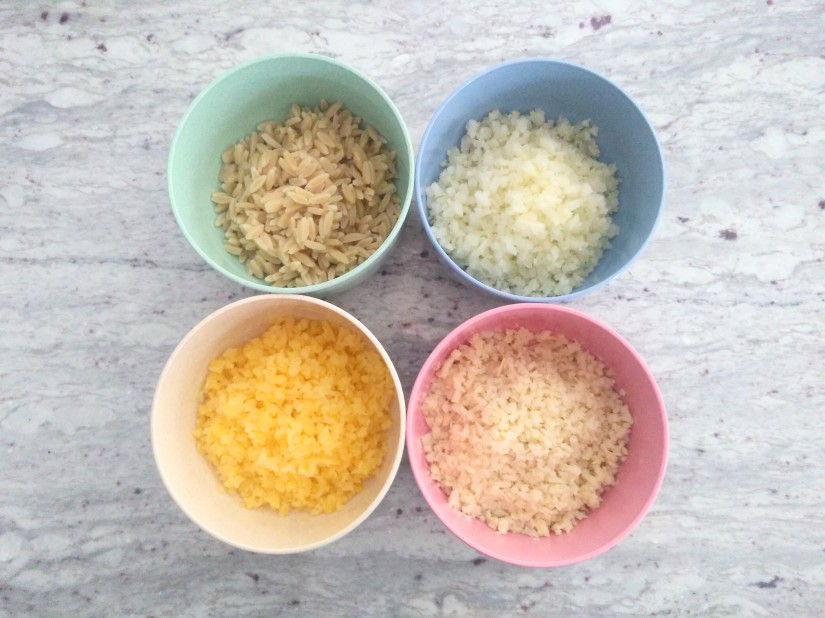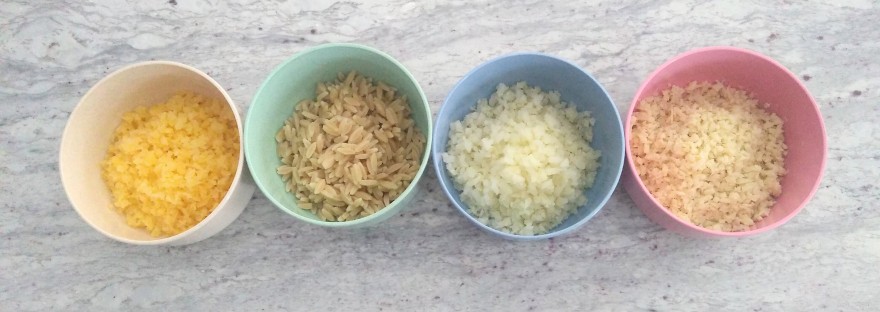Oh rice, you sneaky minx. In terms of food, there’s truly nothing – literally nothing – in the world quite like it. Quinoa and other high carb grains sometimes try to play the part but, they’re definitely not rice. Did you know? 1 cup of rice has 44g net carbs and little nutrition to show for it – save for a tiny amount of potassium and magnesium, and even less protein.
The closest low carb option we’ve tried has been hemp hearts and I suppose that’s because hemp hearts and rice are both seeds. Unfortunately, hemp hearts are extremely calorie dense and 100% cannot be sensibly subbed out in your average dish featuring rice. And other seed varieties (sunflower, sesame, etc.) just don’t boil/cook well to achieve that neutral flavor and soft texture.
Jump to: Low Carb Rice Substitutes | Other Options
The search continues here, as always, but until we find a bang-on alternative, these are the low carb rice substitutes we’ve tried. Some are great, some need a bit of help, and others are a definite “nope”!
This Ketofy My Favorites post features cauliflower (of course), rutabaga, heart of palm, and an orzo-style pasta turned rice from Ciao Carb.
We may make a tiny profit from any affiliate and referral links in this post at no cost to you. This helps us cover some of the domain and hosting costs to keep this site going.
Low Carb Rice Substitutes

Index:
– Ciao Carb Rice
– Cauliflower Rice
– Rutabaga Rice
– Heart of Palm Rice
Ciao Carb’s Nutriwell Pasta Rice

This was an interesting recent find and is currently my husband’s favorite rice alternative. According to the nutrition label, 1 serving (1.7oz dry) is equal to 13g net carbs. We usually split a serving since 2oz makes quite a lot, so about 7g net carbs for us.
This low carb rice is PROTEIN packed, for sure. The overall look and texture definitely lends itself more to a very large, orzo style “rice”, and much like the Great Low Carb Bread Co.’s attempt at orzo/rice, tastes and expands more like a pasta. It’s just too darn big. You need to cook it in boiling water for around 15-20 minutes then strain well, but keep an eye on it because the texture can turn a bit too soft very quickly.
This is the most expensive rice option we’ve tried, so we definitely don’t recommend it for weekly staple meals. However, if you’re tired of cauliflower or no rice-like side – this is the closest non-vegetable orzo substitute we’ve found and the slightly starchy texture is familiar while the taste is bland enough to add whatever flavors you’d like. We originally found it at Netrition and ordered on a whim, really glad we took that chance.
Cauliflower Rice

The running joke is that pretty soon people are gunna try to replace every type of carby food with cauliflower. Ha. Ha. -_-* Now, in case you’ve stumbled on this post after living under a rock for a decade and have no idea what cauliflower rice is – it’s just cauliflower that’s been chopped or grated (usually in a food processor) into a rice-like size and texture. The best texture is achieved by just using the softer floret tops, without much variation in color. Most stores carry premade cauliflower rice/riced cauliflower to varying degrees of quality and the net carbs per serving are usually around 3g.
There are a couple of instances (at best) where cauliflower actually performs well as a substitute, and rice – if cooked correctly – is one of those. Is it at all rice-like? Absolutely not. This is a riced/grated vegetable and will always have that underlying veggie taste. Does it satisfy the need for a lower carb substitute that’s bland enough to flavor however you’d like? Sure thing. Nutrition-wise, it contains a decent amount of potassium per 100g (about 300mg!) along with a crazy high amount of vitamin C. It’s also more convenient, budget-conscious, and less carby than several other options out there. These are the reasons it’s still the best low carb rice substitute and continues to grow in popularity.
There are 2 ways to effectively cook cauliflower rice:
- Microwave: Line a microwave safe bowl with a few sheets of paper towel. Place frozen or raw cauliflower rice on top of the paper towels, cover with a vented microwave safe lid or more paper towels. NOTE: If you’re using frozen riced cauliflower in a steamable bag from the store – do NOT use that bag. Remove the cauli rice from the bag first.
Microwave on high for 2-3 minutes (frozen) or 1-2 minutes (raw). Check the texture, if it’s not soft enough for your tastes, microwave in 15-30 second increments until desired softness is achieved. At this point, you can either serve as a plain “rice” side (we suggest adding a bit of salt) or you can remove some more moisture by fluffing the rice in a hot pan with a small amount of oil for a few minutes.
After microwaving, you can also use it to make fried rice, curry rice, savory rice, baked casseroles, soups, and other recipes you’d normally make with rice. - Oven: Grease a rimmed baking pan. Spread out a single layer of cauliflower rice across the pan and lightly salt (you can add other spices as well). Bake at 450°f for 5 minutes. Take out the pan, give it a little shake, place it back in the oven for another 3-5 minutes.
So, which of these cauliflower rice methods do we recommend?
Option #1! The microwave method yields a soft, fluffy cauli rice that has little to no cauli smell and a really nice texture to use in other recipes or serve as-is. The paper towels help absorb some of the excess water while also lightly steaming.
Option #2 performs the magic of creating a thicker exterior with a slight chew while leaving the inside of the cauli kernel kinda soft. This is equally tasty, but toasting and roasting vegetables like cauliflower INCREASES that cruciferous stank. I wanted to write “smell” there but stank is just way more appropriate. Also, if left too long, it can start to caramelize or turn too mushy. So microwave wins for overall best option here, for sure.
Tip: Do not boil cauliflower rice in water. Like, NEVER. Just don’t do it.
Rutabaga Rice

Cheap, sweet, and STINKY. Rutabaga is a fun alternative for potatoes but did you know it can be riced as well? Most root vegetables can be easily riced because of their tough texture when raw. But this has to be one of the most pungent smelling vegetables we’ve ever worked with. One, VERY LARGE, rutabaga can make upwards of 10+ rice servings for less than $2. While this is a bit more laborious to rice and higher in carbs than the more convenient cauliflower options available, it’s a fun alternative that can naturally sweeten up certain dishes like egg fried rice or Mexican cinnamon rice.
But again, this isn’t close to being like traditional grain rice and definitely lends itself more toward sweet potato dishes. Other riced root vegetables, like parsnips, will yield a different flavor profile but similar texture. Carbs for rutabaga will vary depending on how finely it’s riced, but 100g of rutabaga is about 7g net carbs. If you prefer a huge bowl of sweet “rice”, then you might pass on rutabaga to keep your macros on point, ’cause honestly – it’s a bit addictive once you start eating it…
Heart of Palm Rice

Nope. This was not good. Do not recommend.
Okay, so maybe we didn’t give this a really fair shake as flavors can change dramatically depending on what dish you’re using the rice substitute in – but on it’s own, rinsed, lightly salted, and slightly pan fried, the aftertaste was still extremely unpleasant.
If you’ve had a different experience with riced heart of palm or any tips for how to mitigate that aftertaste, please let us know in the comments!
Other Low Carb Rice Options
We’ve actually tried most of these and vetoed them for various reasons. We’re never able to get a decent texture on the shirataki rice – either too gelatinous or too rubbery. If you know the secret for cooking shirataki, please let us know! The Great Low Carb Bread Co.’s pasta rice is just way too big! And broccoli is… broccoli. We think ThinSlim’s rice might be somewhere in between Ciao Carb and Great Low Carb Bread Co.’s rice offerings but haven’t tried it yet.
Shirataki Rice | Net Carbs per serving: 0g
These are made from the root of the Konjac plant (aka glucomannan), a well known Asian herb. They are pure fiber. Shirataki rice is often in a pouch with fluid that needs to be drained and washed off, but sometimes you can find it dry, which can be rehydrated/steamed later.
Great Low Carb Bread Co. Pasta Rice (Orzo) | Net Carbs per serving: 7g
Ingredients: Pea Protein Isolate, Oat Fiber, Wheat Fiber, Egg Whites, Wheat Gluten, Semolina
ThinSlim Impastable Low Carb Pasta Rice (Orzo) | Net Carbs per serving: 8g
Ingredients: Oat fiber, wheat fiber, wheat protein isolate, egg whites, durum flour
Riced Broccoli | Net Carbs per 100g: 4g
Once you’ve removed most sugar from your diet, broccoli has a very subtle sweetness that makes it unique in the flowery/cruciferous vegetable world. We’re not fans of the texture when it comes to rice but it’s not a terrible substitute, especially when combined with cauliflower.
And last but not least:
For Asian style dishes, consider making lo mein or ramen (with low carb noodles) in place of rice. The textures and flavors for low carb noodles are more on point than any rice substitute we’ve tried so far.


